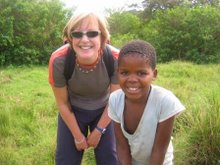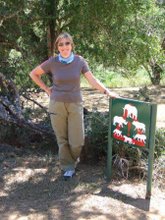...the Italian influence is pervasive; Christian women have crosses tattooed on their foreheads and cover their heads with scarves; men walk down the street holding hands; all restaurant menus include 'fasting options'; greetings between friends in the street involve a complicated ritual of hand shaking, back slapping, shoulder bunting, and cheek kissing...
Yet another kind of Africa.
The Italians weren't here for long, but they certainly left their mark on the cuisine (thankfully!), the place names (Casa de Pesce, Mercato), and the greetings used - ciao and bongiorno are frequently heard. Our hotel neighbourhood is called Piazza, which makes it easy when hailing the mini buses - we are loads better at Italian than Amharic.
Orthodox priests in brocade robes and tasseled hats get onto the buses whenever they stop, holding their locked offerings boxes, sometimes dispensing blessings to individuals, sometimes murmuring general prayers for us all. I saw two priests walking down the road, a woman walking the other way broke her stride just for a moment to bend and kiss the cross one of them carried. There are still mosques and Muslims, but it's Christianity of a peculiarly Ethiopian kind that's most apparent.
After the long trip, we needed some pampering, and treated ourselves to a few good meals, and got our laundry done by someone else. Then it was time to address ourselves to the business of visas. I rang the Egyptian Embassy; it all sounded straightforward, just needed to make sure we had a receipt from when we changed our money (sort of tricky, since we used the recently installed Visa ATM at the local Dashen Bank), and to find them. The directions were, "Find the Lion Park, and then the nearby coffee shop. We are not far." I'm sure this will work.
Next phone call was to the Sudanese Embassy; they too were friendly and English-speaking. All we needed for a visa was $61 US, two photographs, a copy of our passport and a letter of introduction. "A letter?", I enquired. "Yes, a letter of introduction from your embassy." Hmm. We had heard about this but had been hopeful it was just an urban legend. It seemed not. I was being assisted by Nina, who ran the internet cafe downstairs, and had let us use her phone. She insisted that there was both a New Zealand and an Australian embassy in Addis and phoned directory to get the numbers. This resulted in me speaking with both the Netherlands and the Austrian embassies, before we all agreed (most of the customers in the cafe were chipping in with advice at this stage), that it would be best to ring the Brits. Who didn't answer their phone. "They're probably having tea," said Nina, with a straight face.
We realised that the British Council was just round the road, and decided to call in there to see if they could enlighten us at all. Turned out that there were road works outside the Embassy, playing havoc with their phones. We took a cab out there and were informed that the consular section was closed, but that a letter could be arranged at a cost of 1120 bir (about NZ$185). It seemed an incredibly large amount of money, but it turned out to be correct. We returned the next morning, pockets bulging with local currency, filled in a form, and received an obsequiously worded diplo-speak letter addressed to the Sudanese Government, formally introducing us. It had better do the trick!
Next up was the Egyptian Embassy. Somehow their directions worked, and we found them without any real trouble. Max smooth-talked the underworked consular staff, and we managed to get our visa for two months (instead of the usual one), and issued the same day.
We spent the time in between visiting Ethiopia's national museum, just down the road. The most famous exhibit is the fossilised skeleton of "Lucy", a 3.2 million year old hominid discovered in the north-eastern desert of Ethiopia, near the Eritrean border, and a contemporary of the creatures that made the footprints found in northern Tanzania by the Leakeys' team in the mid 1970s that we saw at the Oldupai Museum in the Serengeti. The fossils are lying in one glass boxed exhibit, and alongside, upright, is a replica of her total skeleton, made and donated by the University of Cleveland. While we were there a small group of school children made a lightening visit - one of the girls ran up to the glass box enclosing the replica and kissed it, saying, "I love you Lucy!". It was easy to understand the emotion - most fossils don't have "personality", but somehow Lucy does. Maybe it's because there's so much of her to see, maybe it's because she has a name (the Ethiopians call her "Dinknesh", which apparently translates as wonderful). Apparently her type (Australopithecus afarensis) existed for around a million years - certainly alongside other Australopithecus species, and perhaps alongside early Homo species also. They were small (though it seems the blokes were about twice the size of the women), they walked but could also climb trees and probably slept in them, they followed the migrating herds of herbivores (three-toed horses, giant ibex, and buffalo-type creatures) eating the carcasses of those animals that died naturally (they apparently weren't hunters, nor did they ever discover fire).
We finished the museum experience with the weaving exhibition upstairs. There was a loom and weaver in attendance, and lots of woven textiles - from heavy embroidered rugs and wraps, to light and lacy scarves, plus quite a few artistic and contemporary wall hangings. Interesting to read a story in the paper about efforts to improve the lot of artisans in Ethiopian culture (apparently, doing nothing at all rates more highly socially than being a weaver, goldsmith or potter).
The Sudanese had told me that they were closed on Fridays, so we headed there first thing Monday morning, with all our papers. We have cracked the Addis minibus system, and were there quickly and cheaply (most rides cost 1.20 bir - there are 6 bir to a NZ$). The main problem was finding our way into the compound and we ended up entering via the residential gate, not the consular gate. No matter, we were soon directed to the three-walled corrugated iron shelter serving at the consular office. First we lined up for a form, and completed it. Then it was back to the same line to submit the form, with all appropriate additional paperwork. We were sent to the stationery store across the road to photocopy our Egyptian visas (which luckily we already had), and then had to renegotiate admittance. It was back to the queue, where we were sent off to have all our papers and photos properly stapled together. Finally we were in business. We got some incomprehensible red writing scrawled across our application form, and were sent to the next window's queue. I think at this point some queue jumping went on, and soon enough we were offered a two week transit visa which we gratefully accepted. Then it was off to the cashier round the corner to hand over the money. No, they don't take bir from us, says the accounts clerk as he carefully opens a black briefcase full of loose banknotes of all currencies. We have to pay in US$. With receipts carefully stapled to our bundle of papers, we made our way back to the shelter. Mohammed took our forms and passports and instructed us to come back at 3pm tomorrow. So far so good we figure. It's only taken about 90 minutes. We had planned to head off to Harar in the east on Tuesday, but have decided to stay in Addis for one more day, so we can collect our passports, and hopefully our Sudanese visa stamp.
All things being equal, we have now conquered the bureaucratic hurdles to completing our overland trip to Cairo. We just have to hope the weather is on our side now. We've finally caught up with the rainy season, and some of the roads we have to use could be a problem. We will see.
Monday, 23 July 2007
Subscribe to:
Post Comments (Atom)




No comments:
Post a Comment